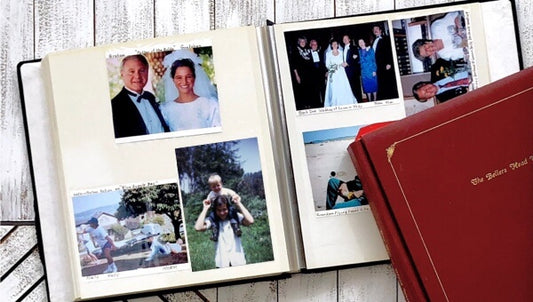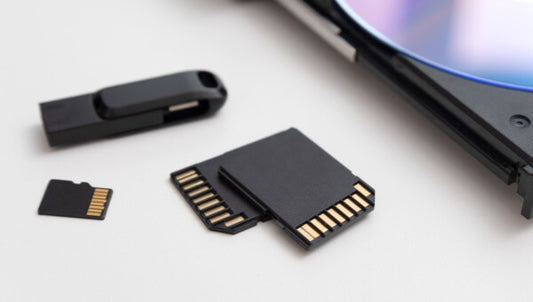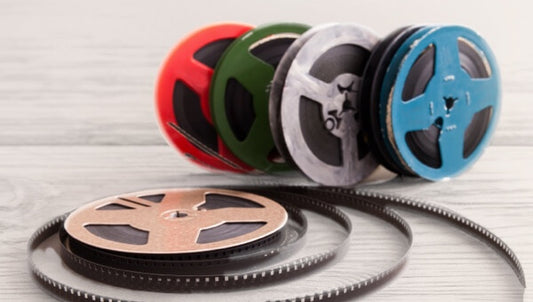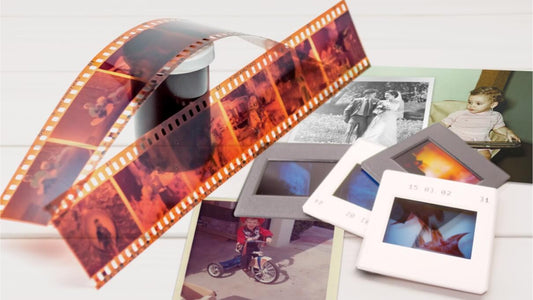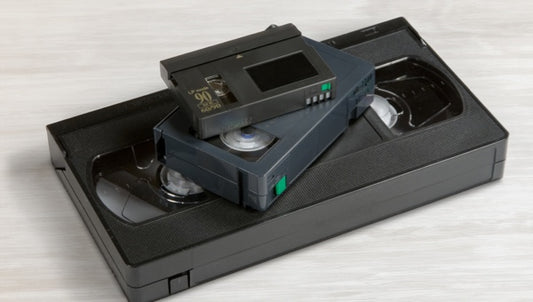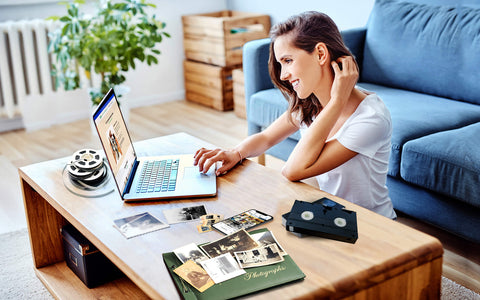Most of us use digital video cameras on our smartphones and might even take them for granted, but the history of the analog video camera goes back much further than you might think. Understanding the history of video cameras can help you appreciate the ability to capture important memories like weddings, graduations, birthdays, and everyday activities with the touch of a button. Capture has preserved over 12 million memories and our archival experts are dedicated to preserving the history of video camera formats. That’s why we put together this guide to not only answer the question, “When were video cameras invented?” but to detail the entire video camera timeline. Keep reading to learn about the origins of video cameras and the changes from the first video camera to digital camcorders as well as uses for video cameras throughout the years and the lasting impact they’ve had on our daily lives.
Jump to:
Evolution of Video Cameras
The evolution of the camera started all the way back in the 1800s with the first motion picture devices. Before that, only still photo methods like daguerreotypes existed. In 1879, Eadweard Muybridge invented the zoopraxiscope, a device that could project up to 200 single images on a screen. A year later, he gave the first public presentation of projected moving images.
Most historians credit Louis Le Prince with creating the first motion video. In 1888, he used a single-lens camera to record Roundhay Garden Scene, a silent film showing people walking in a garden. Other celluloid film cameras soon followed, setting the stage for what would eventually become the old video camera we think of today.

Early Precursors
A few years later in 1891, William Kennedy Laurie Dickson, the employer of Thomas Edison, invented the first movie camera called the Kinetograph to compete with the French Cinematographe made by the Lumiere brothers. While Edison also wanted to create a video camera, this model created by his boss was significantly more successful and could capture 25 mm film images in motion.
While we were still a long way from the video cameras that we recognize, this early video camera technology was crucial for the development of ideas that are still used today. For example, Kazimierz Proszynski invented the Pleograph in 1894 which offered a camera with a projector.
He also developed a camera called the Aeroscope that used compressed air and made it possible for people to capture WWI battles. By that time, video cameras were significantly more accessible to both amateur and professional filmmakers. The camera technology breakthroughs of the time contributed to a massive boom in silent black and white films and theater screenings.
Birth of the Video Camera
Early video cameras were based on the Nipkow disk, an essential component of the first televisions in the early 1900s. This technology led to the first functional video camera when John Logie Baird’s Phonovision was able to directly record video in 1927. Unfortunately, there was no technology to view the footage at the time.
The first commercially released system was the Quadruplex videotape produced by Ampex in 1956 for their Ampex VRX-1000 camera. This camera was only used by television networks due to the exorbitant $50,000 price tag but is recognized as a major technological breakthrough.
Advancements in Recording Technology
From that original commercial video camera, there were some significant video camera advancements. In the 1970s, JVC launched its iconic video home system, the Video Cassette Recorder or VCR. This propelled the use of VHS tapes around the world that made it affordable and easy for people to capture and view immediate playback of their home movies.
Sony also released a competition videotape format called Betamax, which eventually lost out due to the accessible functionality of VHS tapes.VHS made it affordable and easy for families to record home videos and play them back immediately. Around the same time, Sony introduced Betamax tapes, but VHS ultimately won due to its ease of use.
This era of video recording devices leads to handheld camcorders, CCTV, and, eventually, the first digital camera. It began when Sony released the first mass-produced charge-coupled device (CCD) video camera in 1983.
While this technology had been worked on by the American government and private corporations since the 1960s, Sony made it consumer friendly. This was the first step toward the digital revolution in video camera invention history.
The Digital Revolution
The digital revolution completely changed the story of video cameras invented for personal and professional use. New technologies made cameras smaller, more affordable, and easier to use. This shift started with tape formats like Video8 and Hi8 and quickly led to digital breakthroughs that shaped modern video recording.

Video8, Hi8, And the Move Toward Digital
The digital revolution started with Video8, an 8mm analog tape format introduced in the mid-1980s. While Video8 only recorded analog footage, it set the stage for improved formats like Hi8, which offered better picture quality and the ability to record digital audio.
These improvements eventually led to Digital8, a fully digital recording format. Digital8 allowed users to record and store high-quality digital footage directly on traditional 8mm tapes, making it a practical choice for consumers upgrading from analog camcorders.
The Rise of the Sony Handycam
In 1985, Sony’s Handycam Video8 changed home video forever. This compact camcorder showed how video cameras invented for families could be small, affordable, and easy to carry. Families no longer needed bulky equipment to record vacations, birthdays, or school events.
The Handycam line continued evolving, adding new features like metadata recording, night vision, SD card storage, and even built-in DVD recording in later models. Sony’s Handycam became a trusted name for personal video recording, shaping the way people captured everyday moments.
CCD Technology Improves Video Quality
Throughout the mid to late 1980s, companies like Panasonic and JVC adopted Sony’s charge-coupled device (CCD) technology. This technology allowed video cameras to capture sharper images, improved color accuracy, and better low-light performance.
The result was clearer action shots, better footage in challenging lighting, and improved recording quality - all while keeping cameras affordable for regular consumers. CCD technology became a standard part of most video cameras invented after this period.
The Shift to High-Definition and Tapeless Recording
By the late 1990s and early 2000s, video camera technology shifted once again. In 2003, Sony introduced the first completely digital video camcorder that didn’t rely on tapes or discs. This was a major turning point, as users could now store footage directly on internal memory or memory cards.
At the same time, high-definition (HD) video became more accessible. Sony and other brands developed consumer-friendly HD camcorders, giving families and independent creators access to stunning visual quality without the need for professional equipment.
Video Cameras Move to Cell Phones
It didn’t take long for innovators to realize the next big step: adding cameras to mobile phones. The first cell phone with a built-in camera was launched by Sharp in 2000, followed shortly after by Samsung.
These video cameras invented for cell phones were basic at first, but they borrowed some technology from DSLR cameras made by Nikon and Canon. Over time, mobile phone cameras evolved to capture higher-resolution video, add zoom capabilities, and offer built-in editing tools - all from a device small enough to fit in your pocket.
The Digital Revolution Redefined Video Forever
The digital revolution made recording easier, cheaper, and more accessible for everyone. From Video8 to smartphones, each step forward built on the technology that came before. What started as video cameras invented for professionals became tools anyone could use, helping people capture and share life’s moments like never before.
Video Cameras and Industries
With such a long history, it’s no wonder that video cameras have offered a variety of beneficial uses for both professional industries and personal use. These are some of the major uses of video cameras and how the story unfolded for each.

Filmmaking and Television Production
While film cameras worked just fine for some uses, video cameras made it much easier and more affordable to record television shows and motion pictures. Affordability made the editing process cheaper while also making it possible to re-record and add different visual effects.
Film formats like Super 8 or 8mm film reels could not be reused. That meant every day of filming added new costs for film stock and development. Editors had to physically cut and splice film strips to make changes, which was time-consuming and left little room for error. With video cameras invented to record directly to tape, the process became easier and much cheaper.
Digital video cameras took these benefits even further. We could review digital footage instantly, transfer it to computers, and edit it with modern software. This also opened the door to special effects, CGI, and digital overlays, all of which are now standard in the film and television industries. Green screen technology, which allows filmmakers to swap backgrounds digitally, also became far easier thanks to digital video cameras.
Surveillance and Security
Before video cameras invented for surveillance became available, monitoring public or private spaces was difficult and impractical. Early systems were bulky and expensive, limiting their use to a handful of government facilities.
It’s believed that one of the first surveillance cameras appeared in Soviet Russia in the 1920s. However, the first official CCTV system, widely recognized by historians, was installed in Nazi Germany during World War II to monitor rocket launches. This innovation laid the groundwork for modern security systems.
From there, video cameras invented for security purposes evolved into the CCTV networks used in banks, airports, and public streets today. By the 1970s and 80s, businesses and governments across the world relied on these systems for public safety and crime prevention. In the digital age, surveillance technology advanced further. Today’s security cameras connect to the internet, allowing live remote viewing through smartphones. Digital storage also allows you to save months or even years of footage without physical tapes.
Journalism and Reporting
Visual journalism was almost unheard of before video cameras invented for reporting made real-time event capture possible. Before video, film cameras were impractical for field reporting because they were fragile, expensive, and difficult to operate quickly.
With video cameras invented to record directly to tape, journalists could document breaking news as it unfolded. This ability changed how we gather and broadcast news, making visual storytelling a key part of modern journalism.
For example, the moon landing was recorded using data tape recorders, allowing audiences around the world to witness history. As video cameras became more affordable in the 1980s, camcorders allowed local reporters — and even everyday people — to capture events on the spot. This led to the rise of citizen journalism, where individuals documented protests, natural disasters, and other historic moments with personal camcorders.
The digital shift took this further, making high-definition video recording available to anyone with a smartphone. Today’s ability to livestream events or capture high-quality video with a phone is possible thanks to decades of innovation built on the foundation laid by video cameras invented for journalism.
Personal Video Recording
Video cameras invented for home use made a lasting impact on personal history preservation. In the 1980s, camcorders that used VHS tapes became common household items, allowing families to record birthdays, holidays, and vacations with ease.
This marked a major turning point for personal video recording. Before video cameras invented for families became affordable, home movies were rare and required expensive film equipment. VHS camcorders changed that by giving families a simple way to record everyday life without:
- Professional training
- Costly film stock
- Complex editing equipment
With digital technology, sharing those recordings became even easier. Today, anyone can instantly send videos through:
- Social media platforms
- Video calls
The ability to attend virtual family events or share real-time moments with loved ones across the globe all comes from the same technological progress that started with the earliest video cameras invented for home use.
To keep those moments safe and accessible for future generations, it’s smart to convert old home movies to digital. This way, you protect your family’s history and make it easy to watch and share those videos anytime.

Digitize Your Old Videos Today
While the first early film camera technologies were introduced in the late 19th century using celluloid film, the history of the video camera really begins with the Nipkow disc. From there came video cameras that used data tapes and eventually videotapes that made it possible for families to capture video. It also led to security cameras, cell phone videos, and the ability to create social media videos and share them with the world. Because of that, knowing when were video cameras invented demonstrates the start of a lone timeline that continues to impact our lives on a daily basis. It’s important to preserve our video camera memories to maintain our legacy and ensure that history is never lost. Capture is one of the companies that convert VHS to digital and digitize videotapes and photos. We will help you ensure future generations can cherish your memories.





